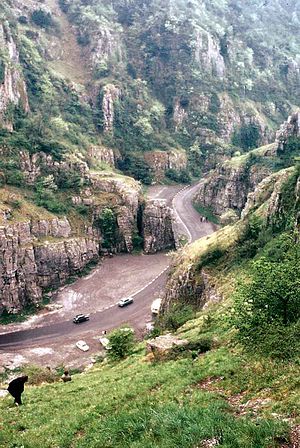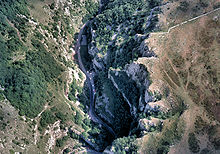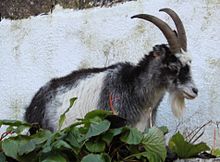- Cheddar Gorge
-
This article is about a geographical feature in Somerset, England. For the game, see Cheddar Gorge (game).
Cheddar Gorge is a limestone gorge in the Mendip Hills, near the village of Cheddar in Somerset, England. The gorge is the site of the Cheddar show caves, where Britain's oldest complete human skeleton, Cheddar Man, estimated to be 9,000 years old, was found in 1903.[1] Older remains from the Upper Late Palaeolithic era (12,000–13,000 years ago) have been found.[2] The caves, produced by the activity of an underground river, contain stalactites and stalagmites.
Cheddar Gorge, including the caves and other attractions, has become a tourist destination. In a 2005 poll of Radio Times readers, following its appearance on the 2005 television programme Seven Natural Wonders, Cheddar Gorge was named as the second greatest natural wonder in Britain, surpassed only by Dan yr Ogof caves.[3] The gorge attracts about 500,000 visitors per year.[4]
Contents
Geography
Cheddar is a gorge lying on the southern edge of the Mendip Hills.[5] The maximum depth of the gorge is 137 m (449 ft),[6][7] with a near-vertical cliff-face to the south, and steep grassy slopes to the north. The B3135 road runs along the bottom of the gorge.
The area is underlain by Black Rock slate, Burrington Oolite and Clifton Down Limestone of the Carboniferous Limestone Series, which contain ooliths and fossil debris, on top of Old Red Sandstone and by Dolomitic Conglomerate of the Keuper. Evidence for Variscan orogeny is seen in the sheared rock and cleaved shales. In many places weathering of these strata has resulted in the formation of immature calcareous soils.[8]
The gorge was formed by meltwater floods during the cold periglacial periods which have occurred over the last 1.2 million years. During the ice ages permafrost blocked the caves with ice and frozen mud and made the limestone impermeable. When this melted during the summers water was forced to flow on the surface, and carved out the gorge.[9] During warmer periods the water flowed underground through the permeable limestone, creating the caves and leaving the gorge dry, so that today much of the gorge has no river until the underground Cheddar Yeo river emerges in the lower part from Gough's Cave. The river is used by Bristol Water, who maintain a series of dams and ponds which supply the nearby Cheddar Reservoir,[10][11] via a 137-centimetre (54 in) diameter pipe that takes water just upstream of the Rotary Club Sensory Garden, a public park in the gorge opposite Jacob's Ladder.
The gorge is susceptible to flooding. In the Great Flood of 1968 the flow of water washed large boulders down the gorge and damaging the cafe and entrance to Gough's Cave,[12] and washing away cars.[13] In the cave itself the flooding lasted for three days.[14]
Ecology
The gorge is part of a Site of Special Scientific Interest now called Cheddar Complex.[8]
The south side of the gorge is owned and administered by the Marquess of Bath's Longleat Estate. The cliffs on the north side of the gorge are owned by The National Trust.[15] Every year both of the gorge's owners contribute funds towards the clearance of scrub bush and trees from the area. Longleat Estate has fenced off a large part of its land and has introduced goats, as part of a programme to encourage the biodiversity of the area; the goats were intended to replace the sheep that grazed in the gorge until the 1970s.[16] The National Trust announced in March 2007 that they plan to release a flock of sheep on its side of the gorge for the same purpose, but will first consult local residents and interested parties on whether to fence off the gorge or introduce cattle grids to prevent the sheep from straying. There is already a small flock of feral Soay sheep in the gorge. Other notable species at the gorge include dormice, yellow-necked mice, slow worms and adders and the rare large blue butterfly (Maculinea arion),[17] and small pearl-bordered fritillary (Boloria selene).[8]
A wide variety of wild birds can be seen in the gorge including peregrine falcons, buzzards, kestrels, ravens[18] and the Grasshopper Warbler (Locustella naevia).[8]
The flora include chalk grassland-loving species such as marjoram and wild thyme.[17] The Cheddar pink, (Dianthus gratianopolitanus), also known as firewitch,[5] a type of Dianthus only grows in the wild in the gorge.[19] It was once common in the gorge but declined after being picked by collectors. It is also home to unique species of Whitebeam.[20] The nationally rare little robin geranium (purpureum), and Cheddar bedstraw (Galium fleurotii) and the nationally scarce species include slender tare (Vicia tenuissima), dwarf mouse-ear (Cerastium pumilum) and rock stonecrop (Sedum forsteranum) also occur in the gorge.[8] It is one of the very few areas in southern Britain where the lichens Solorina saccata, Squamaria cartilaginea and Caloplaca cirrochroa can be found.[8]
The gorge is also an important site for whitebeams and in 2009 a survey was carried out by botanists from the Welsh National Herbarium as part of a nationwide survey of whitebeams. Among the eight secies identified were three new species previously unknown to science. Nineteen specimens with oval-shaped leaves, were named the "Cheddar whitebeam", Sorbus cheddarensis, fifteen specimens with roundish leaves and greyish brown bark were named the "Twin Cliffs whitebeam", Sorbus eminentoides, and thirteen with long, narrow leaves were named "Gough’s Rock whitebeam", Sorbus rupicoloides.[21][22] The Cheddar whitebeam, which has evolved as a cross between the common whitebeam and the grey-leaved whitebeam, is unique to the gorge, but its survival is threatened by the goats that were introduced specifically to keep down the growth of new trees and encourage the proliferation of rare plant species such as the Cheddar pink. Cuttings have been taken from the trees to be grafted and grown on at the Welsh National Herbarium.[23]
Caves
Two main caves are open to the public – the extensive Gough's Cave and the smaller Cox's Cave, named after their respective discoverers. Both are known for their geology, and it has been suggested that the caves were the site of prehistoric cheese-making.[24] Gough's cave, which was discovered in 1903,[25] leads around 400 m (437 yd) into the rock-face, and contains a variety of large rock chambers and formations. Cox's Cave, discovered in 1837,[26] is smaller but contains many intricate formations. A further cave houses a children's entertainment walk known as the "Crystal Quest".[27]
The Gorge's many caves are home to colonies of Greater and Lesser horseshoe bats.[28]
In 1999 the Channel 4 Time Team television programme investigated Cooper's Hole to see if they could find evidence of Palaeolithic human activity.[29]
Recreational use
There are about 350 officially graded climbing routes on the 27 cliffs that make up Cheddar Gorge, which are generally open to climbers between 1 October and 15 March each year. Each of the routes is named and included in the British Mountaineering Council guidebook. Although the majority of the climbs are "trad" or "traditional", which means that the leader places protection as they go up, there are also some "sport" routes where bolts are left in place. Climber Chris Bonington was the first to scale the Coronation Street route in 1965.[30]
Visitors to the gorge have experienced a number of accidents.[31][32] Rescue services, including local mountain rescue and cave rescue groups, frequently use the gorge to stage exercises. It is also used as a training location for military rescue helicopter pilots.
The Cheddar Man Museum of Prehistory inspired by the discovery of ancient hominids such as Cheddar Man contains information about the caves and their palaeontological development. Exhibits include original flint tools and human remains excavated from the caves.
There is a clifftop walk from Jacob's Ladder along the crest of the gorge and back to the road, with views of the gorge. A caving experience is offered within Gough's Cave. There is a path of 274 steps, built up the side of the gorge, known as Jacob's Ladder after the Biblical description of a ladder to the heavens. A watchtower at the top provides a 360–degree view of the entire area and village. An open-top bus tour operates during the summer. Cheddar cheese is made in the lower part of the gorge.
 View of Cheddar Village, reservoir, Batts Combe quarry and gorge taken from the watchtower at the top of Jacob's Ladder
View of Cheddar Village, reservoir, Batts Combe quarry and gorge taken from the watchtower at the top of Jacob's Ladder
Cultural references
Cheddar Gorge is a panel game played on the BBC Radio 4 series I'm Sorry I Haven't a Clue.[33] The gorge was used as a location for a Chimeran Tower in the Resistance: Fall of Man, a science fiction first-person shooter video game for the PlayStation 3, developed by Insomniac Games.[34]
Cheddar Gorge was the site of Into the Labyrinth starring Ron Moody and Pamela Salem.
See also
- Geology of the United Kingdom
References
- Notes
- ^ "Tourist hotspots - Cheddar Gorge". BBC. http://www.bbc.co.uk/naturescalendar/summer/honeypots/cheddar/cheddar_gorge.shtml. Retrieved 2007-08-12.
- ^ "Somerset Historic Environment Record". Somerset County Council. January 1983. http://webapp1.somerset.gov.uk/her/details.asp?prn=10398. Retrieved 2007-08-12.
- ^ "Caves win 'natural wonder' vote". BBC. 2005-08-02. http://news.bbc.co.uk/2/hi/uk_news/wales/mid_/4735935.stm. Retrieved 2007-08-12.
- ^ "Access Q&A: Cheddar Gorge". British Mountaineering Council. 1999. http://www.thebmc.co.uk/Feature.aspx?id=1843. Retrieved 2007-08-12.
- ^ a b "Tourist hotspots - Cheddar Gorge". Natures Calendar. BBC. http://www.bbc.co.uk/naturescalendar/summer/honeypots/cheddar/cheddar_gorge.shtml. Retrieved 2008-09-10.
- ^ "Cheddar Gorge and Caves Jacobs Ladder Tourist Information". http://www.iknow-somerset.co.uk/tourist_information/central_somerset/cheddar/cheddar_gorge_showcaves.htm.
- ^ "Cheddar Gorge and Caves: the natural wonder home to everyone". http://www.bbc.co.uk/somerset/content/articles/2008/10/20/cheddar_gorge_feature.shtml.
- ^ a b c d e f "The Cheddar Complex" (PDF). English Nature. http://www.english-nature.org.uk/citation/citation_photo/1003940.pdf. Retrieved 2006-07-17.
- ^ "Cheddar Gorge". British Geological Survey. http://www.bgs.ac.uk/mendips/localities/cheddar.html. Retrieved 2008-09-10.
- ^ "Draft Water Resource Plan" (PDF). Bristol Water. 18 April 2008. pp. 21. http://www.bristol-water.co.uk/pdf/environment/w2008/WRP%202010%20v1.1%20D%20REP.pdf. Retrieved 2008-09-10.
- ^ "Cheddar Reservoir Introduction". Bristol Water. http://www.bristolwater.co.uk/leisure/cheddar-info.asp. Retrieved 2008-09-10.
- ^ "40 years since the Great Gorge Flood". Western Mercury. 10 July 2008. http://www.thewestonmercury.co.uk/news/40_years_since_the_great_gorge_flood_1_321776. Retrieved 24 February 2011.
- ^ "The Chew Valley floods of 1968". Environment Agency. http://www.publow-with-pensford-pc.gov.uk/pub/backlook/env_agency_leaflet.pdf. Retrieved 24 February 2011.
- ^ Donovan, D.T. (2006). "Gough's Cave, Cheddar, Somerset. Quaternary Stratigraphy". Proceedings of the University of Bristol Speleological Society 24 (1): 17–35. http://www.ubss.org.uk/resources/proceedings/vol24/UBSS_Proc_24_1_17-35.pdf. Retrieved 24 February 2011.
- ^ "Access Q&A". British Mountaineering Council. http://www.thebmc.co.uk/Feature.aspx?id=1843. Retrieved 2008-09-10.
- ^ "Research news". Bristol University. 5 May 2006. http://www.bristol.ac.uk/news/2006/11468378167.html. Retrieved 2007-08-12.
- ^ a b "The best places to watch wildlife in Britain". The Independent. 24 November 2006. http://www.independent.co.uk/environment/nature/the-best-places-to-watch-wildlife-in-britain-425636.html. Retrieved 2007-08-12.
- ^ "Cheddar Gorgeous birds". RSPB. http://www.rspb.org.uk/datewithnature/sites/cheddargorge/index.asp. Retrieved 2010-09-18.
- ^ Leete-Hodge, Lornie (1985). Curiosities of Somerset. Bodmin: Bossiney Books. pp. 21–22. ISBN 0906456983.
- ^ "Three new species of tree identified in Cheddar Gorge". The Times. http://www.timesonline.co.uk/tol/news/environment/article6969783.ece. Retrieved 14 November 2010.
- ^ Anon (29 December 2009). "New tree species discovered in Cheddar Gorge". telegraph.co.uk (Telegraph Media Group Limited). http://www.telegraph.co.uk/earth/earthnews/6902489/New-tree-species-discovered-in-Cheddar-Gorge.html. Retrieved 21 February 2010.
- ^ de Bruxelles, Simon (29 December 2009). "Three new species of tree identified in Cheddar Gorge". The Times (Times Newspapers Ltd.). http://www.timesonline.co.uk/tol/news/environment/article6969783.ece. Retrieved 21 February 2010.
- ^ Country File, Produced by Andrea Buffery, Babara Lewis and Andrew Tomlinson: Broadcast 22 February 2010: BBC Television
- ^ "Food and Drink In European Prehistory" (PDF). archaeologyonline.org, published by Saveock Water Archaeology. http://www.archaeologyonline.org/Documents/FoodDrink.pdf. Retrieved 2007-08-12.
- ^ "Gough's Cave excavation site". Natural History Museum. http://piclib.nhm.ac.uk/piclib/www/image.php?search=cave&getprev=73539. Retrieved 2007-08-15.
- ^ "Cheddar Caves and Cheddar Gorge". BirminghamUk.com. http://www.birminghamuk.com/cheddar.htm. Retrieved 2007-08-15.
- ^ "Cox's Cave and the Crystal Cave". Cheddar Caves and Gorge. http://www.cheddarcaves.co.uk/section.php/22/1/cox_s_cave___the_crystal_quest. Retrieved 18 December 2009.
- ^ Park, Kirsty J.; Jones, Gareth; Ransome, Roger D. (November 4, 1998). "Winter activity of a population of greater horseshoe bats". Journal of Zoology (Cambridge University Press) 248 (4): 419–427. doi:10.1111/j.1469-7998.1999.tb01041.x. http://journals.cambridge.org/action/displayAbstract;jsessionid=0FDDAEB00B899ED1E506A093BD4F8287.tomcat1?fromPage=online&aid=41519. Retrieved 2007-08-12.
- ^ "Cheddar Gorge, Somerset". Time Team. Channel 4. http://www.channel4.com/history/microsites/T/timeteam/archive/cheddar.html. Retrieved 2008-09-10.
- ^ "ExWeb Special: The Life and Climbs of Chris Bonington, part 3". ExplorersWeb. mounteverest.net. http://www.mounteverest.net/news.php?id=1200. Retrieved 2010-02-07.
- ^ "Man injured in Cheddar Gorge fall". BBC News. 24 March 2007. http://news.bbc.co.uk/1/hi/england/somerset/6490889.stm. Retrieved 2007-07-15.
- ^ "Woman rescued from gorge cliffs". BBC News. 30 October 2006. http://news.bbc.co.uk/1/hi/england/somerset/6100820.stm. Retrieved 2007-07-15.
- ^ "I'm Sorry I Have not a Clue". BBC 7. http://www.bbc.co.uk/bbc7/comedy/progpages/clue.shtml. Retrieved 2008-09-11.
- ^ Hardcastle, Jim (August 2007). "Climbing Cheddar's crags". Mendip Times: p. 41. http://www.mendiptimes.co.uk/. Retrieved 2007-07-27.
External links
- Cheddar Caves and Gorge, a commercial company operating some of the tourist attractions in the Gorge
- British Geological Survey information about Cheddar Gorge
Coordinates: 51°16′57″N 2°45′56″W / 51.282409°N 2.765460°W
Categories:- Mendip Hills
- Bat roosts in England
- Canyons and gorges of England
- Geography of Somerset
- Visitor attractions in Somerset
- National Trust properties in Somerset
Wikimedia Foundation. 2010.





